
“I love France”, he once told Paris Match. On his tour through Major European Citys to promote The Conqueror, John Wayne arrives at the Paris Saint-Lazare train station...

...and is leaving Paris on a TWA flight bound for Chicago.
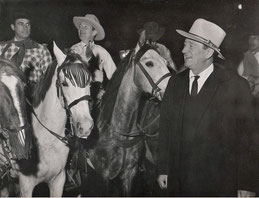
As he returns four years later to shoot his Longest Day scenes, he gets a real cowboy reception. When in Paris, Wayne loved to stay at the Hotel George V., the famous hotel located near the Arc de Triomphe, at 31 Avenue George V. His last stay was during the shooting of Brannigan, when he took Pat Stacy to Paris over the weekend. They stayed in Suite 152. During his last weekend in Paris, Wayne dined and wined Pat Stacey at La Tour d’Argent, the 400-year old restaurant at 17 Quai de la Tournelle.
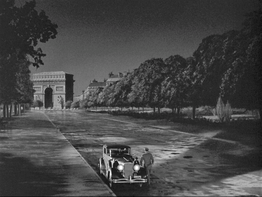
His movie character went to France long before he did himself: all the Paris scenes in the 1942 melodrama Reunion in France were achieved with matte shots and...

...even though theReunion in France marquees boasted Wayne's face with the Eiffel Tower, the streets of Nazi occupied Paris were recreated on the MGM lot. The same was true 20 years later, for the Paris scenes of Circus World: When Matt Masters stops the stagecoach on the Champs-Ellysées, he's actually in the Parco Retiro in Madrid.
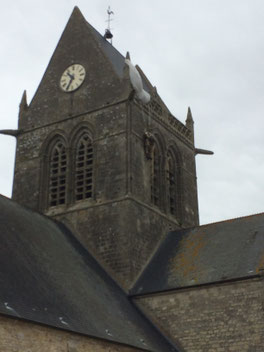
In 1962, Wayne had agreed to do a cameo in Darryl F. Zanuck's The Longest Day. Sainte-Mère-Église on the Contentin peninsula is the objective of Wayne’s paratroopers. Each June, the townfolks make sure there is a rubber paratrooper hanging from their famous church tower in memory of that fatal night. The unique Airborne Museum in the town’s center features life-sized scenes of the nightly drama. The church’s interior and its pulpit from which Jean-Louis Barroult delivers a flaming sermon remain unchanged. However, John Wayne himself never went to that town as...
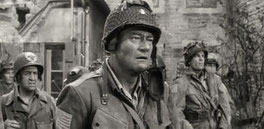
...his fine bit of action – the reaction shot when he “sees” his dead men – was accomplished while staring at a blank studio wall in the Studios de Boulogne in Paris. While the dead bodies hanging from telephone poles in the town square were actually filmed in Ste-Mère-Eglise, they were inserted into Wayne’s studio footage.

Zanuck set a trend for future international productions when he used the Boulogne studios in Paris. The fifty-two sets included the full deck of destroyer. A landing craft was constructed ingeniously to simulate movement in the heavy sea. A wide expanse of typical Normandy countryside, divided by a running stream, covered two full stages, the largest movie set ever created in France. Sadly, the once-mighty Studios de Boulogne is cut down to being a TV facility at 2 rue de Silly, with all former glory lost.

As a matter of fact, due to Wayne's short time on the movie, not even his only scene outside the studio was shot in Normandy but just outside Paris, as it clearly does not resemble the typical Norman lancscape.
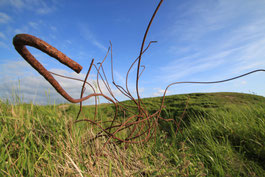
Apart from that, Zanuck shot the original locations of the D-Day invasion as often as possible. He received permission to use flame-throwers on the pockmarked Pointe du Hoc to clear the area, now a national monument. They also cleared out 600 live land mines in the area.

Robert Wagner, Fabian, Paul Anka and Tommy Sands were helped by
150 Rangers of the Eight Division, transported from their base in Wiesbaden, Germany, to recreate the daring taking of the eighty-foot cliff.
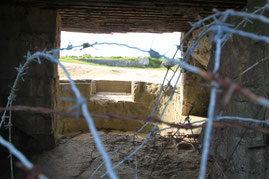
“The one we're after”, George Segal tells the matinee idols Tommy Sands and Fabian when he has a thick-walled bunker in his sights. This main objective of the Pointe du Hoc sequence can still be located on the former battlefield. It appeared again in Zanuck’s 1969 documentary, D-Day Revisited, with which he wished to boost the re-release, and he is actually landing on top of that bunker in a helicopter in true showman-style.
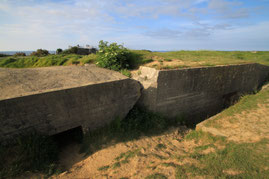
Nearby is another half-sunken bunker. It was the backdrop of a very daring scene at the time: Tommy Sands shoots Germans who want to surrender, then utters: "I wonder what bitte-bitte means."

Utah Beach was easy to access and back then existed just by a strip of sand dunes. The place where Henry Fonda delivers Gen. Theodore Roosevelt’s famous line, “We’re starting the war from right here”, was shot approximately where this memorial now stands. The son of U.S. President Theodore Roosevelt is buried on the Normandy American Cemetery & Memorial, on a bluff overlooking Omaha Beach in Colleville.
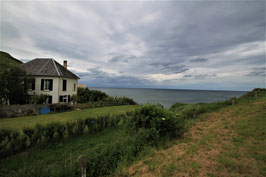
Not far from Colleville, in a place called Honorine des Pertes, on the Rue de la Mer, they filmed the episode of the German (Gert Fröbe) who gets the surprise of his life as he spots the Allied Armada while on horseback.
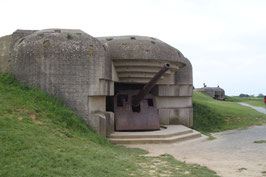
The battery of Longue-sur-mer still retains its original guns and was used in several sequences and...

...the largest bunker of the garrison at 39 Rue de la Mer, overlooking the sea, was used as the German command post in the film (where Pluskat spots the Allied fleet from).

One of the most ambitious sequences was the French commando assault, beautifully orchestrated in one continuous, four-minute helicopter shot. As the real Ouistreham didn’t resemble the town at wartime anymore, the nearby town of Port-en-Bessin in which some bombed-out buildings were still in existence stood in. The picturesque stretch of houses along the canal is the same as it looked in the sequence.
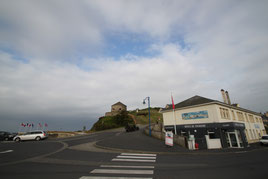
The small fishing town was evacuated as the capture of the casino was recreated. The tourist office to the right stands in the place where the bullit riddled house in the movie stood. Special effects filled in old shell holes of the old Vauban tower at Rue du Castel (seen in the middle of this photo), just to blow them out again for the camera.
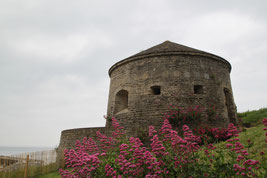
The Vauban tower overlooking the harbor is now restored to its original appearance.

The fearless nuns marched down this street to care for the wounded French troops.

Zanuck had built a number of gliders for the sequence of the taking of the Pegasus Bridge at Bénouville. A monument for the fallen paraglider troops stands in its place today.

Richard Todd (middle) was actually a D-Day participant. In the movie, he wears the beret he wore that day. He donated his original gear to the Café Gondrée, 12 Avenue du Commandant Kieffer, where it is displayed to this day.

In 1992, the original bridge which was used in the movie was transported to a museum nearby, on Avenue du Major Howard, and can be admired there, thanks to John Howard and the veterans who protested when authorities wanted to replace “their bridge” with a rather different styled one.
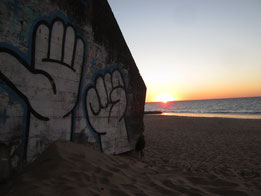
Zanuck took over the Ile de Ré at the French west coast; the completely flat island facing the Bay of Biscay offered beaches that were good for shooting over wide distances. With the exception of Utah Beach, its beaches were used for the recreation of all the landings. The bunker-strewn Conche des Baleines, to the north of the island, was wisely chosen to portray Omaha Beach....
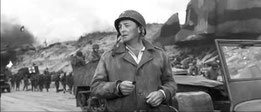
...captured by Robert Mitchum. In real life, the German fortifications had never seen action, they were abandoned when the Wehrmacht retreated.

The half-submerged remains are now a popular meeting place of the island’s teenagers. Zanuck’s engineers even unearthed several 50mm German anti-aircraft guns.
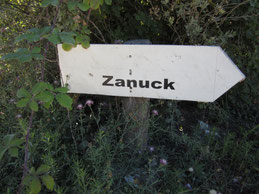
A passage was dug out for the scene in which the G.I.’s finally breach the seawall and storm inland. That place is now named “Pas Zanuck”.
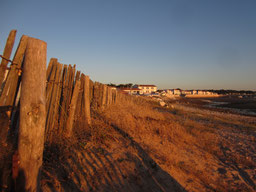
To the east of the island, Rivedoux-Plage, the sickle-shaped Sablanceaux shore was converted into the landing beaches Sword, Gold and Juno. The bridge that connects the island with La Rochelle, the huge Pont-de-l’Ile de Ré, had not yet been built, so the wide-angle shot from the point of view of an attacking Stuka flyer coming over Sword beach was possible.

The historic Château de Chantilly, about thirty miles north of Paris, is well known among movie lovers as a James Bond location. In A View to a Kill, the famous horse stable was the estate of super gangster Christopher Walken. In The Longest Day...
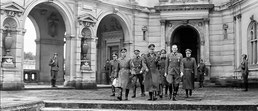
...it became the headquarters of German field marshal Rommel.
©All text content on this website is protected by copyright and other intellectual property laws. No part may be reproduced without the prior written permission. All photos courtesy of Roland Schaefli, unless otherwise stated.
This website is in no way associated with the John Wayne Estate or business enterprises. Go to johnwayne.com to find the official website and to https://johnwayne.org/ to read about the wonderful John Wayne Cancer Foundation.
more john wayne locations to scout
If you like this site, you'll like the book: the first comprehensive guide to the John Wayne Locations, with hundreds of then-and-now photos, unpublished behind-the-scenes-pictures and detailed tour descriptions
Tracking John Wayne: The complete Tourguide
Find directions to locations and anecdotes from the Duke's movie sets in this new publication from McFarland, available at bookstores and online shops
For all locations mentioned on this website, the book offers behind-the-scenes stories, making-of anecdotes and never before published photos

